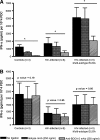Plasmacytoid dendritic cell number and responses to Toll-like receptor 7 and 9 agonists vary in HIV Type 1-infected individuals in relation to clinical state
- PMID: 23131038
- PMCID: PMC3581027
- DOI: 10.1089/aid.2012.0200
Plasmacytoid dendritic cell number and responses to Toll-like receptor 7 and 9 agonists vary in HIV Type 1-infected individuals in relation to clinical state
Abstract
In HIV-1 infection, plasmacytoid dendritic cell (PDC) numbers and function are decreased. No detailed comparisons of PDC responses to various stimuli in HIV-1-infected patients are available. Using for the first time purified PDCs, we compared PDC responses [interferon (IFN)-α production/cell] to various stimuli in a large number (n=48) of HIV-1-infected patients and healthy volunteers (n=19). Toll-like receptor (TLR)7- and TLR9-induced expression of PDC surface activation and maturation markers was also compared in the two populations. We have confirmed that PDC number coincides with CD4(+) T cell counts and clinical state. Notably, we have shown that a direct association of PDC function in terms of IFN-α production/cell exists with PDC numbers and CD4(+) cell counts when PDCs are exposed to a TLR9 ligand and HIV-infected cells, but not with a TLR7 ligand. Moreover, in the HIV-infected subjects but not the healthy controls, the magnitude of IFN-α release per PDC in response to the TLR7 ligand is significantly (p<0.01) lower than that to the TLR9 ligand. However, in both study populations, the TLR7 stimulation in comparison to TLR9 stimulation induced higher expression of PDC surface activation and maturation markers and significantly (p<0.05) decreased the expression of BDCA-2, a negative regulator of interferon. Furthermore, the cross-ligation of BDCA-2 significantly (p<0.05) inhibited TLR9- but not TLR7-induced IFN-α production by PDCs from both clinical groups. These findings suggest that differences exist in TLR7- and TLR9-induced IFN-α production by PDCs in HIV-infected individuals that are not directly related to BDCA-2 down-modulation.
Figures









Similar articles
-
TLR9/TLR7-triggered downregulation of BDCA2 expression on human plasmacytoid dendritic cells from healthy individuals and lupus patients.Clin Immunol. 2008 Oct;129(1):40-8. doi: 10.1016/j.clim.2008.06.004. Epub 2008 Aug 5. Clin Immunol. 2008. PMID: 18684674
-
Bruton's tyrosine kinase regulates TLR9 but not TLR7 signaling in human plasmacytoid dendritic cells.Eur J Immunol. 2014 Apr;44(4):1130-6. doi: 10.1002/eji.201344030. Epub 2014 Jan 20. Eur J Immunol. 2014. PMID: 24375473
-
Blocking TLR7- and TLR9-mediated IFN-α production by plasmacytoid dendritic cells does not diminish immune activation in early SIV infection.PLoS Pathog. 2013;9(7):e1003530. doi: 10.1371/journal.ppat.1003530. Epub 2013 Jul 25. PLoS Pathog. 2013. PMID: 23935491 Free PMC article.
-
Signalling pathways leading to IFN-alpha production in human plasmacytoid dendritic cell and the possible use of agonists or antagonists of TLR7 and TLR9 in clinical indications.J Intern Med. 2009 Jan;265(1):43-57. doi: 10.1111/j.1365-2796.2008.02050.x. J Intern Med. 2009. PMID: 19093959 Review.
-
Sex Differences in Primary HIV Infection: Revisiting the Role of TLR7-Driven Type 1 IFN Production by Plasmacytoid Dendritic Cells in Women.Front Immunol. 2021 Aug 27;12:729233. doi: 10.3389/fimmu.2021.729233. eCollection 2021. Front Immunol. 2021. PMID: 34512664 Free PMC article. Review.
Cited by
-
Relationships between IL-17(+) subsets, Tregs and pDCs that distinguish among SIV infected elite controllers, low, medium and high viral load rhesus macaques.PLoS One. 2013 Apr 19;8(4):e61264. doi: 10.1371/journal.pone.0061264. Print 2013. PLoS One. 2013. PMID: 23620737 Free PMC article.
-
Short Communication: Exploring Antibody Potential as Prophylactic/Therapeutic Strategies for Prevention of Early Mucosal HIV-1 Infection.AIDS Res Hum Retroviruses. 2015 Nov;31(11):1187-91. doi: 10.1089/AID.2015.0041. Epub 2015 Sep 10. AIDS Res Hum Retroviruses. 2015. PMID: 26252799 Free PMC article.
-
HIV-1-exposed seronegative individuals show alteration in TLR expression and pro-inflammatory cytokine production ex vivo: An innate immune quiescence status?Immunol Res. 2016 Feb;64(1):280-90. doi: 10.1007/s12026-015-8748-8. Immunol Res. 2016. PMID: 26616295
-
Influence of Human Papillomavirus E7 Oncoprotein on Maturation and Function of Plasmacytoid Dendritic Cells In Vitro.Virol Sin. 2018 Dec;33(6):493-501. doi: 10.1007/s12250-018-0069-3. Epub 2018 Dec 19. Virol Sin. 2018. PMID: 30569289 Free PMC article.
-
Opiate use inhibits TLR9 signaling pathway in vivo: possible role in pathogenesis of HIV-1 infection.Sci Rep. 2017 Oct 12;7(1):13071. doi: 10.1038/s41598-017-12066-3. Sci Rep. 2017. PMID: 29026137 Free PMC article.
References
-
- Siegal FP. Kadowaki N. Shodell M, et al. The nature of the principal type 1 interferon-producing cells in human blood. Science. 1999;284:1835–1837. - PubMed
-
- Cella M. Jarrossay D. Facchetti F, et al. Plasmacytoid monocytes migrate to inflamed lymph nodes and produce large amounts of type I interferon. Nat Med. 1999;5:919–923. - PubMed
-
- Colonna M. Trinchieri G. Liu YJ. Plasmacytoid dendritic cells in immunity. Nat Immunol. 2004;5:1219–1226. - PubMed
-
- Liu YJ. IPC: Professional type 1 interferon-producing cells and plasmacytoid dendritic cell precursors. Annu Rev Immunol. 2005;23:275–306. - PubMed
Publication types
MeSH terms
Substances
Grants and funding
LinkOut - more resources
Full Text Sources
Other Literature Sources
Medical
Research Materials

